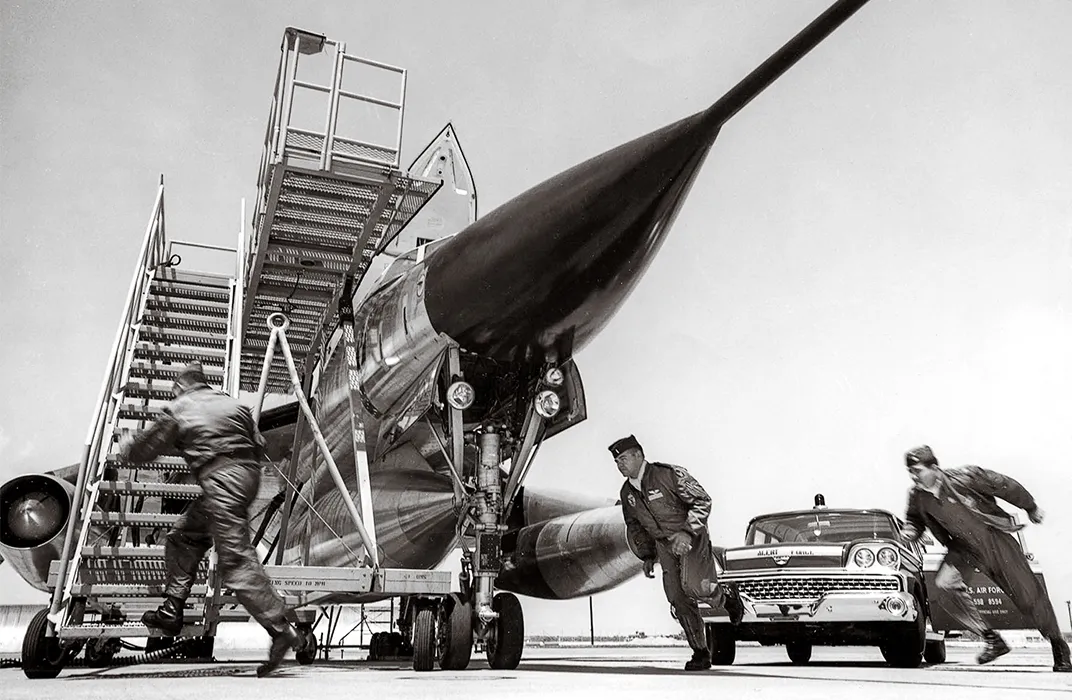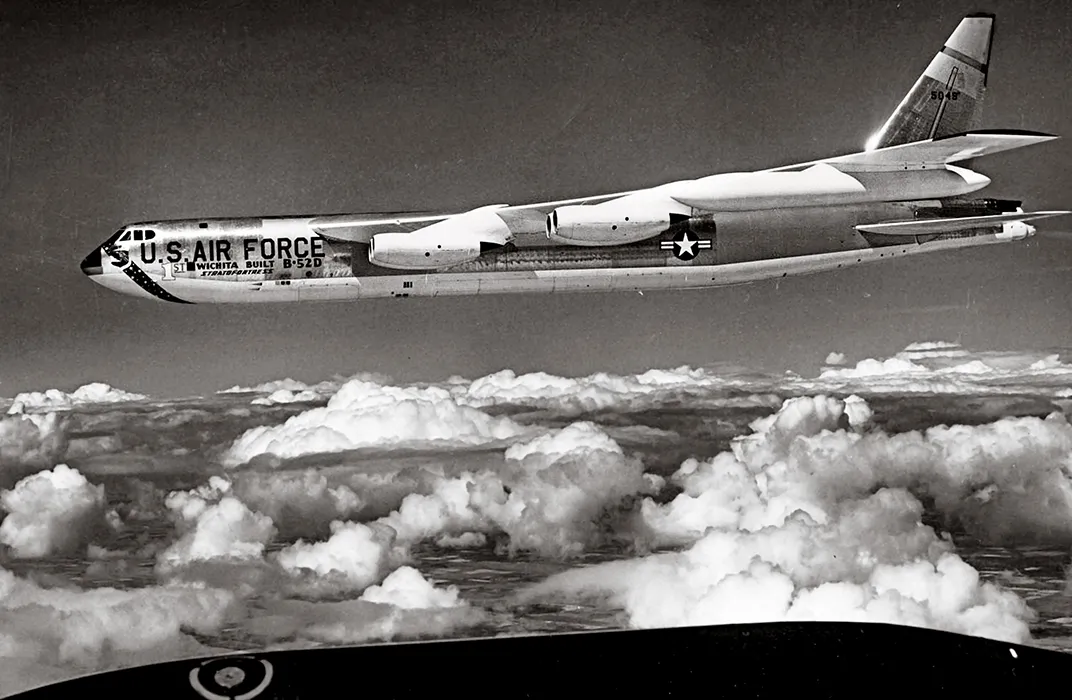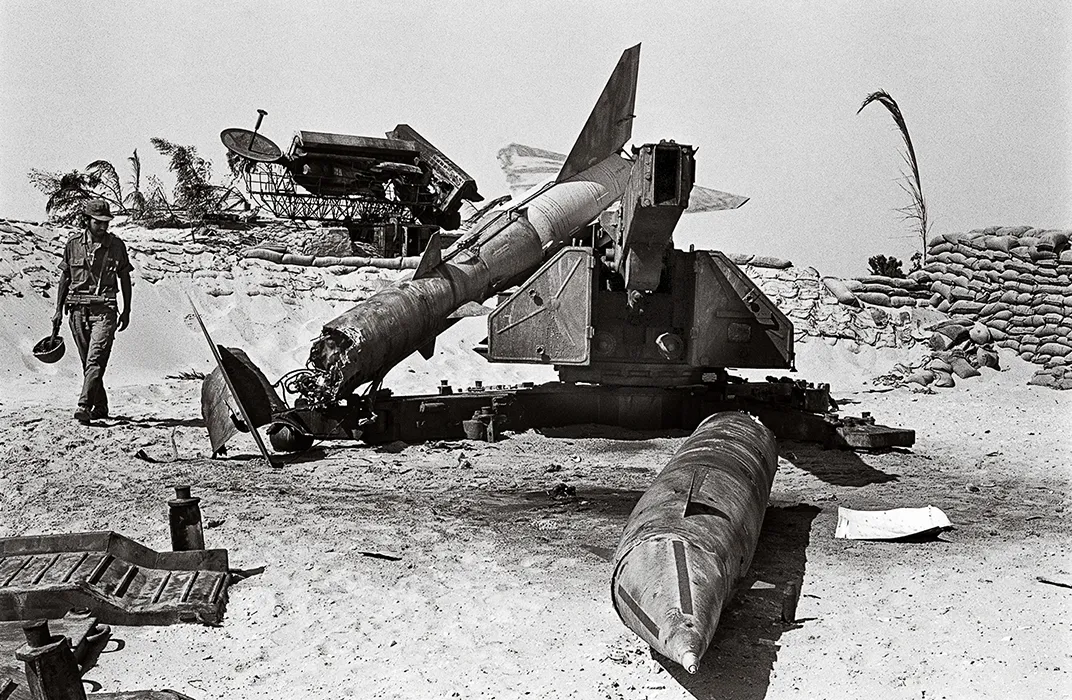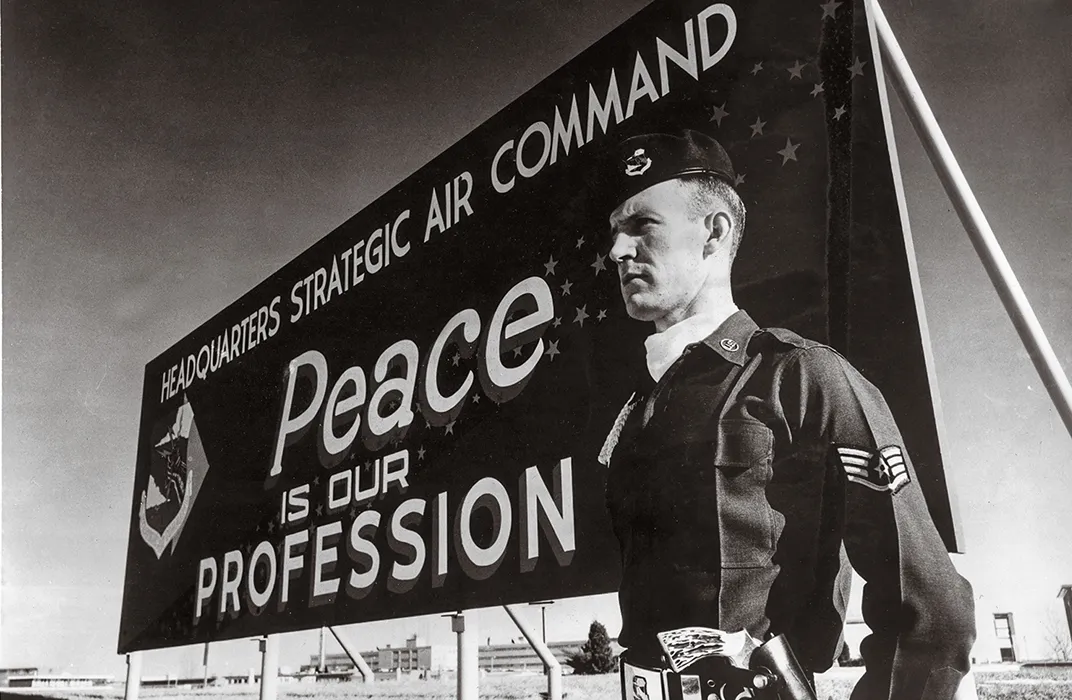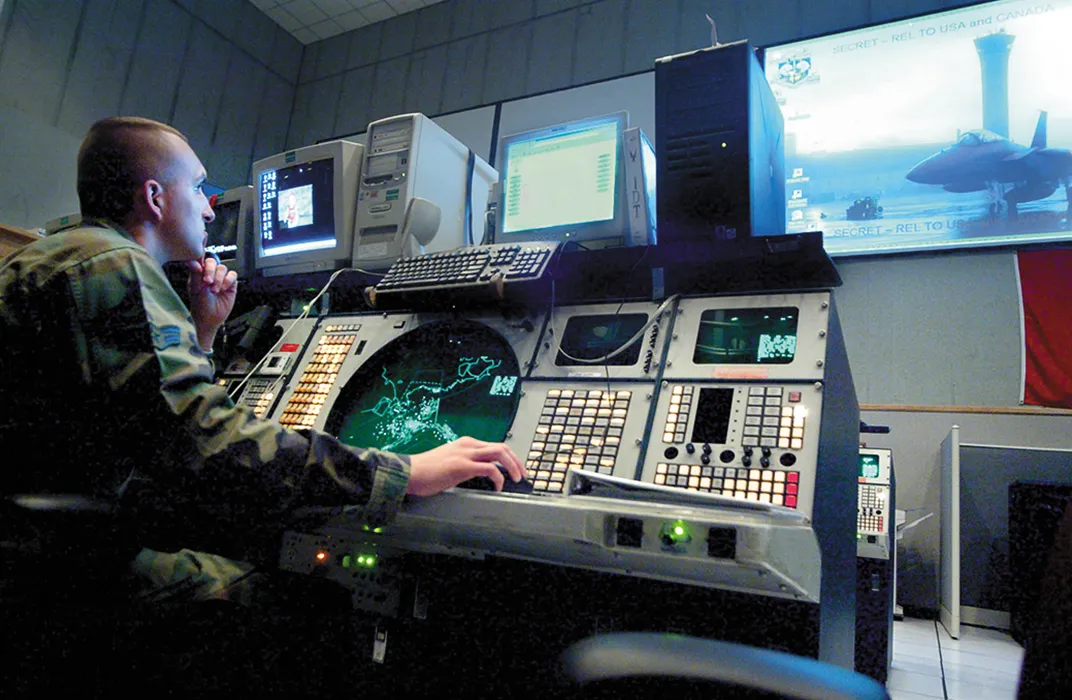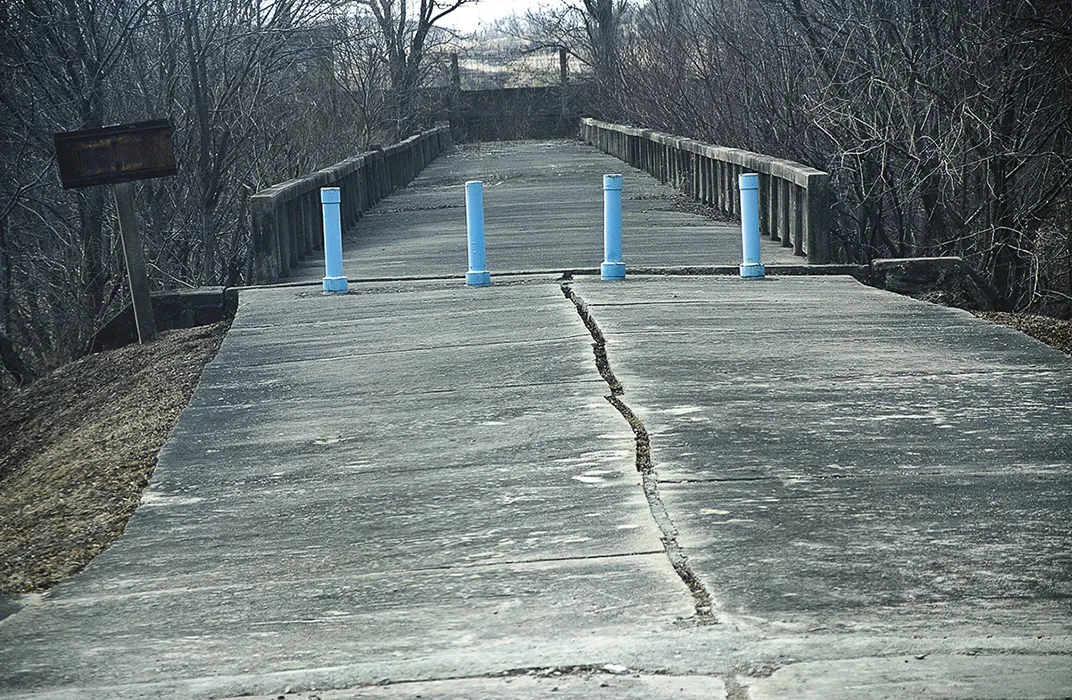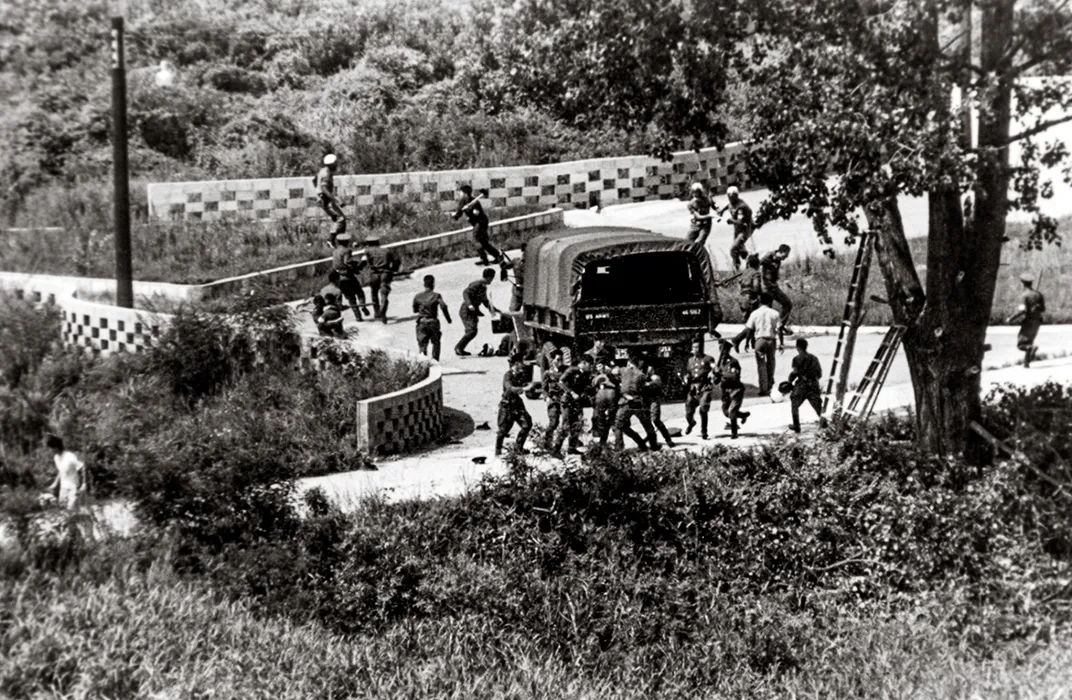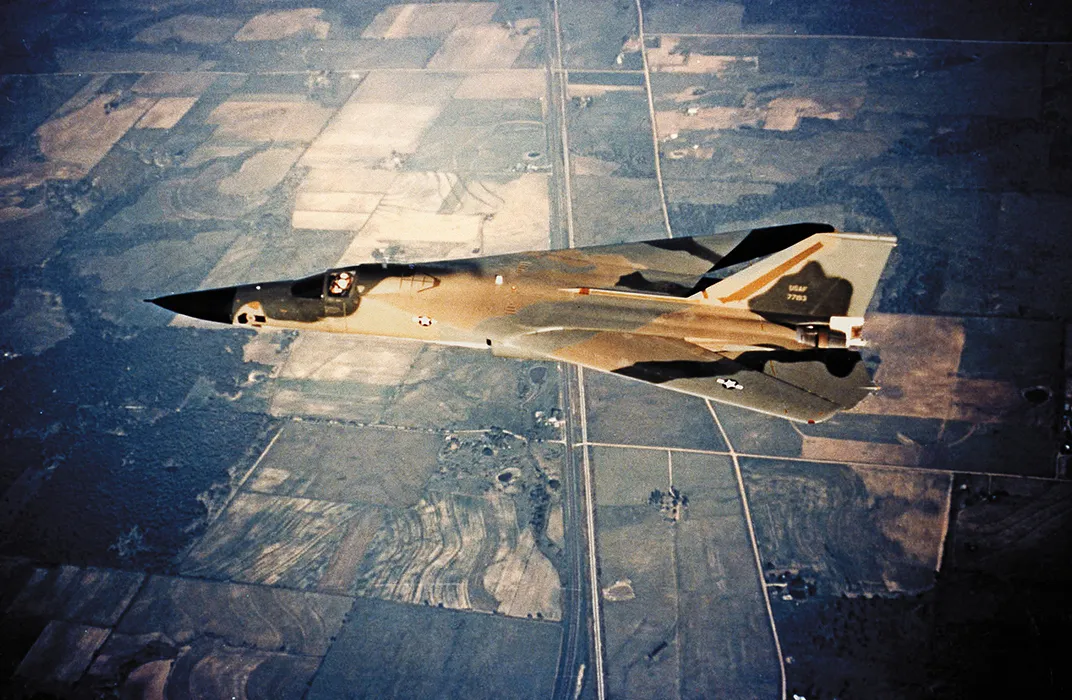Go To DEFCON 3
These are the steps to follow right before you hear “Incoming!”
/https://tf-cmsv2-smithsonianmag-media.s3.amazonaws.com/filer/60/79/60790d15-c72f-4bbe-93e2-cec9272c9bdd/01_defcon_feb_14.jpg)
For most sailors on board the USS Wisconsin in January 1991, the first they heard of Operation Desert Storm was an announcement from the commanding officer, Captain David Bill. The battleship, Bill told them over the loudspeaker, was now at DEFCON 2. According to Robert Ruby, a newspaper reporter embedded on the ship, one officer grabbed a spy novel to find out what the alert meant.
It’s embarrassing, perhaps, but not that surprising—this concept from the depths of the cold war still has so much popular fascination it has blurred under constant use. The term shows up in TV shows and movies, video games, cartoons, songs, and even hot-sauce labels. Going to the international hackers convention? That’s a DEF CON. A high DEFCON level is now techno-slang for a situation so pressing that it needs prompt, extreme action.
What’s “high”? Screenwriters often get the scale wrong, so begin with this fact: the lower the number, the higher the worry. DEFCON 5 is peacetime, while DEFCON 1 is imminent war. Hiking the DEFCON level activates a stack of scripted plans intended for quick execution, and is comparable to “Battle stations!” on a warship facing combat.
The idea of a graded scale indicating combat readiness goes back at least to World War I, but it wasn’t until 1959, following communication mixups during a joint military air-defense exercise called Top Hand, that the United States and Canada agreed to five “defense conditions,” or DEFCONs.
DEFCON levels are primarily for the military. But as the levels get more urgent—certainly by DEFCON 2 and 1—Americans would notice unusual activity on the streets. White House staff on duty during the Cuban Missile Crisis later recounted plans to evacuate them from Washington by helicopter. (That would have happened immediately under DEFCON 2, to be triggered if the United States moved to invade Cuba to disable the Soviet missiles there.) Preparations to flee started under DEFCON 3. High officials got pink cards authorizing helicopter seats, specifying time and location. What about their families? Kennedy press secretary Pierre Salinger received an envelope on October 27, 1962, the height of the crisis: If his wife discovered that Salinger had gone into hiding, she was to rip it open for instructions on how to slip out of the city and join up later.
Real DEFCON alerts, as opposed to the ones in movies, don’t have to directly involve U.S. global defenses. At least a dozen alerts have been called for limited geographic areas since 1959, some of them imposed by commanders for individual units. Only four world-class DEFCON hikes are known: a very brief one caused by a Soviet-American diplomatic breakdown during talks in Paris (May 1960); the Cuban Missile Crisis (October to November 1962); a U.S. alert aimed at discouraging direct Soviet participation in the Arab-Israeli war in the Mideast (October 1973); and a hasty move to raise security around military bases after the terror attacks of September 11, 2001. In the last case, the military knew that a worldwide hike to DEFCON 3 was not well suited as a response to terrorists using hijacked airliners, but according to Bruce Blair of Princeton University, in the first uncertain hours, authorities seized on it as the quickest way to secure the perimeters of U.S. military bases. Blair is the author of The Logic of Accidental Nuclear War and a former Minuteman launch officer. Side effects of the DEFCON 3 order that day included “continuity of government” routines that restricted the mobility of the president and vice president, slammed shut the blast doors at the NORAD Cheyenne Mountain Complex, and put bomber and missile bases on a short-notice alert.
No worldwide DEFCON alerts have jumped beyond level 3. The Strategic Air Command went to DEFCON 2 during the Cuban crisis, which was probably as close as the United States has ever come to tipping into a nuclear war since late 1956 (when a revolt in Hungary against the Soviets coincided with an international crisis along the Suez Canal).
Two DEFCON alerts that came late in the cold war were directly authorized by the Joint Chiefs of Staff at the direction of the White House in the hope of avoiding war: the worldwide alert in October 1973 and a limited one centered on the Korean Demilitarized Zone in August 1976. Although the decision makers intended the DEFCON orders to prevent armed engagement, there were moments in both alerts that could have gotten away from them. When I asked how close the 1976 crisis came to an exchange of bombs and missiles, one participant, an infantryman with UN command troops, suggested I put my finger and thumb together, just short of touching: “We were that close,” he said.
The events of October 1973 help explain why alerts have both risks and benefits. On one hand, calling a DEFCON hike can forestall opponents’ aggression by sending the message “We know what you’re planning and we’re ready, so don’t try anything.” But staging military alerts too frequently, or for the wrong reasons, can cause political backlash and exhaust the ranks.
Late on the night of October 24, 1973, a national security team in the Nixon administration authorized a DEFCON 3 alert for U.S. forces worldwide. Setting aside the larger geopolitics, the initial triggering event, on October 6, was Egypt and Syria leading a surprise attack on Israel. For the first few days, the tide of war favored the attackers: Israel sustained horrific aircraft and armor losses as Egyptian armor and infantry surged across temporary bridges over the Suez Canal, then broke through huge sand barriers on the Israeli side. Syrian tanks overran Israeli fortifications on the Golan Heights and looked likely to drive straight into Jerusalem. Israeli losses were so grave that soldiers were authorized to attach nuclear warheads to the nation’s Jericho missiles.
The crisis pulled in the Soviets, who had been supplying advisers, ammunition, and equipment to the Arab nations for years, and the Americans, who had been giving foreign aid to Israel.
Each country shipped arms to its chosen side, but in a matter of days, Israeli jets and ground forces stopped the invaders and blocked the Egyptians from retreating west across the Suez Canal.
Wanting to build on its spectacular gains, Israel stalled the rollout of a cease fire resolution from the United Nations. Now the Soviets and their Arab allies were the ones pressing for a halt to hostilities. After two weeks, the crisis was less about battles on the ground and more about the roles of the United States and the Soviet Union: Would the Soviets send in “peacekeeping” troops to relieve the Egyptian Third Army? U.S. intelligence reported that the Soviets had put seven airborne divisions on alert, a move that, along with a change in aerial resupply traffic, seemed to indicate troops were on their way.
Henry Kissinger, Nixon’s Secretary of State, feared that the arrival of Soviet ground troops in a Middle East war would lead to a dangerous spiral of moves and counter-moves. He wanted a sudden, dramatic gesture—suggesting the United States was willing to go to the brink of world war—to prevent the Soviet intervention. The decision to go to DEFCON 3 was made by Kissinger and his advisory team, the Washington Special Actions Group.
The resulting Pentagon order told commanders to pull out their DEFCON 3 plans and carry them out. In such circumstances, commanders have authority to take extra actions in the interest of readiness and defense…within limits.
For Bruce Blair, then a Minuteman missile officer on duty in an underground launch control capsule at Malmstrom Air Force Base in Montana, the first news of the DEFCON came over the Primary Alerting System, a voice network connecting all SAC installations to headquarters at Offutt Air Force Base in Nebraska. It started with a warble tone by loudspeaker, and a verbal alert to prepare for a coded message.
Blair and his fellow officer got out their binders and grease pencils, and learned that DEFCON 3 was now in effect: After verifying the message with all launch centers in the squadron, each pair of officers made sure the blast doors were closed. Each officer opened a safe and took out a launch key and the Sealed Authentication System code card, laying them on the console for quick use. The items remained on the console for the duration of the alert, including shift changes. Why the preparations? “A little less time would be necessary if [these actions were] done in advance,” Blair explains. “An officer might forget the combination to the padlock on his safe. Also the procedure puts you in the right frame of mind.” After the men’s shifts finished and they returned to quarters, orders confined Blair and his colleagues to their homes as long as the alert lasted—in this case, two days.
Steve Winkle was a 28-year-old Air Force captain, trained to navigate for B-52Ds operating out of Andersen Air Force Base in Guam. When the DEFCON order came down and the alert klaxon blew, he was on a porch overlooking the airfield. As other crews on alert raced from their barracks to the aircraft, he noticed that the normal gaggle of officers who watched such practices were absent; it was such a common sight that the men at Andersen had a name for the phenomenon: a Gathering of Eagles.
“Then we got a phone call, told to report to the briefing room,” Winkle recalls. “Till then it was ‘Here we go, another exercise.’ With the exception that no commanders were there to watch, we didn’t see the difference. Then in the briefing room the lights went out and we heard ‘SAC is in DEFCON 3.’ The room went totally silent. To be crude about it, you could have heard a fish fart.” After the intelligence briefing was over, the next job was to increase the number of B-52Ds available to launch. Winkle’s flight crew prepared two more bombers and handed them over to alert crews, then stood alert on the third bomber.
Winkle and fellow crew members waited out the event on base, staying close to the alert barracks. Out on the ramp, separate security crews guarded each aircraft, which were, in the parlance of SAC, “cocked”: nuclear bombs loaded; fueled; and carrying aboard the highly classified war orders known as combat mission folders.
According to a cold war recollection posted on the website fb-111a.net by former FB-111A pilot Ed MacNeil, the combat mission folders posed a real problem during the alert for his two-man crew at Pease Air Force Base in New Hampshire. Summoned by phone at 1:30 a.m., MacNeil left his home and was at the base long before the 5:30 target briefing. He and his navigator received their combat mission folders at 7 a.m. The folder triggered special security requirements: Until the bomber was formally on alert—when it would be guarded by base security—no person could hold a folder without another officer present as escort. It was the equivalent of the “no-lone zone” that governed custody of nuclear weapons.
The FB-111A had a crew of just two men, so under military rules MacNeil and his partner had to hold tight to the highly classified folders, each keeping the other in sight at all times. This meant they could not catch any sleep. One could not go to the bathroom without the other. “Rest was becoming critical because if the crisis worsened, the next logical step would have been to disperse some of the alert aircraft to other air fields to keep from having ‘too many eggs in one basket,’ ” wrote MacNeil, who died last year. “We had had less than two hours sleep in the previous 36 hours, the weather both at Pease and at the dispersal base was near minimums and the aircraft was heavier than I had ever flown it. I was becoming uncomfortable with the odds.” At 6:30 that evening, the bomber was ready. Security took over and MacNeil could finally get some rest.
The worldwide DEFCON 3 alert had little immediate effect on U.S. naval forces in the Mediterranean, which were already at a high operational tempo and “nose to nose” with the warships of the Soviet Fifth Eskadra, according to Robert Rubel. Then a lieutenant and now dean of the Naval Warfare Center at the Naval War College, Rubel arrived on the carrier USS Independence during the crisis, fresh from A-7 transition training. Part of the U.S. Sixth Fleet, the Independence was positioned south of Crete and close to Soviet air resupply routes. The presence of the ship sent a message about America’s commitment to Israel while also serving as a “lily pad” to refuel tactical aircraft en route to Israel and guarding the American aerial resupply line.
During the day, the principal assignment for Rubel and his comrades was to fly around to inspect the sources of radar returns picked up by an E-2 Hawkeye checking on activity in the Soviet fleet. While orbiting over the opposition at 15,000 feet, he says, “our job was to keep an eye on the decks. If we saw the smoke of a missile launch, we’d send a Zippo report back, as in ‘Hey, World War III is on.’ The idea was that we’d get that report out before we died.
“It was a crappy situation,” Rubel adds. One problem was that the U.S. fleet had no long-distance anti-ship missiles comparable to those on the Soviet ships. “And all their [warships] had surface-to-air missiles.” Having only unguided 500-pound bombs, the A-7 pilots planned to descend on the Soviet ships “like [Douglas Dauntless pilot Wade] McClusky dive-bombing on the Japanese carriers at Midway.”
The worldwide DEFCON hike ended on October 26: The Soviets did not attempt to land troops in Egypt, peace broke out, and Kissinger’s team allowed the U.S. fleet to separate from the Fifth Eskadra in late October, whereupon tensions rapidly fell. In mid-November the fleet stood down from DEFCON 3.
DEFCONs can be focused more narrowly than the 1973 “Worldwide, no exceptions” order. The Joint Chiefs and White House can order DEFCON changes that are specific to one arm of the military or to a geographic command during a crisis. A vivid example of the latter occurred in August 1976, when U.S. Forces–Korea bumped up to DEFCON 3 at the direction of the Ford White House. The preparations pulled in an armada of B-52s from Guam, fighter-bombers from the USS Midway carrier group, F-111Fs from Idaho, and F-4 Phantoms from as far away as Florida. Events moved very quickly, and received little press attention outside Korea.
The 1976 DEFCON hike that centered on the Korean DMZ was different not just because of its geographic focus, but also because it had a specific military action in mind. According to Air Force historian Jerome Martin, the 1976 Korean crisis “was an interesting event in which the DEFCON change did the two things that are normally expected: It improved the readiness of the forces that might be employed, and provided a strong signal of U.S. concern and potential intent to act militarily.”
The visible effects of shifting from DEFCON 4 to 3 included increased SR-71 reconnaissance flights and hundreds of trucks moving artillery and ammunition to fortified bunkers near the DMZ. Nike-Hercules missile bases there shifted from air defense to ground targeting: Their job would be to destroy North Korean radar sites.
The most dramatic moments of the event were crammed into less than 72 hours. The crisis started late in the morning of August 18 (Korea time) and was mostly resolved by 8 a.m. on August 21. It ranks as one of the fastest developing, most obscure DEFCON alerts ever authorized by the National Command Authorities.
The cause of the crisis was a tree. It stood in the Joint Security Area, a roughly circular patch of buildings, roads, and observation posts near Panmunjom that was patrolled by the North Korean People’s Army and United Nations Command. The UN Command was staffed by elite troops from the South Korean and U.S. armies, selected for size, toughness, and discipline. Each side kept hundreds of heavily armed troops in barracks a short distance away to respond to firefights, but in the JSA itself, UN and North Korean troops were banned from carrying weapons more powerful than sidearms.
Geographically, the JSA was a small but important part of the Demilitarized Zone between North and South Korea; it was the location of the Bridge of No Return, where prisoners were exchanged. Also crowded into the river valley were buildings for meetings and a set of observation posts for each side to watch the other. While the JSA was supposed to be a peaceful, neutral zone for resolving disagreements, harassment attacks on isolated troops were on the rise—sometimes brutal enough to send men to the hospital—so in mid-August, officers in the UN Command decided that because a large poplar tree blocked a view between guard posts in the JSA, it needed a trim.
Following notifications to the North Koreans, on the morning of August 18, a work team of Americans and South Koreans arrived at the tree and prepared to begin work. Minutes later, dozens of North Koreans arrived to confront the team. Then, on command from a sergeant, they attacked with axes. The fight was over in minutes; although no shots were fired, two American officers lay dead.
The UN Command evacuated the casualties; the question was how to respond. It was the latest in a long line of outrages: The North Koreans had shot down a U.S. intelligence-gathering airplane (1969), captured the USS Pueblo from international waters (1968) and held the crew hostage, and tried to assassinate South Korean President Park Chung-hee (also 1968).
In command of U.S. Forces–Korea was General Richard Stilwell, who notified Washington of the attack. Intense discussions opened between Stilwell’s headquarters, the Kissinger-led crisis team called the Washington Special Actions Group, and President Park. Nobody knew the North Korean motive for the violence, but agreed that orders must have come from the supreme commander, Kim Il-Sung. North Korea was already sending out communiques blaming the Americans for the melee, but the propaganda was being disputed by American photographs that documented the entire fight.
Whatever the enemy reasoning, South Korea and U.S. leaders wanted to push back quickly. The North had taken no hostages during the attack, so the United States had more freedom of action than it had during the Pueblo crisis. The planning moved in a matter of hours rather than days. Air-attack advocates suggested that the United States blow up the tree, perhaps with a precision-guided bomb called the GBU-15 (a new weapon, not officially in use), which could convert the tree into toothpicks while other U.S. airplanes attacked targets inside North Korea. This group figured that a second try at trimming the tree would send men into a deathtrap, where zeroed-in North Korean artillery and machine guns would kill them all in seconds. Deputy Secretary of Defense William Clements was one of these who feared a trap. Some pressed for naval action to sink North Korean ships, or flatten harbor facilities.
The ground approach, pressed by Stilwell and his staff, reasoned that the tree stood as a symbol of the North’s intransigence, and had to be taken out by infantry action as a sign of resolve. An early-morning action backed by air support would, Stilwell believed, finish the job before the North Koreans could act.
President Park suggested to Stilwell that the North Koreans be given plenty of notice before a second tree-trimming squad went in. Then, when the North Korean troops stormed into the JSA to attack a second time, they would be met by 50 “expert Tae-Kwan-Do artists” from the nation’s special forces, who would deliver a “sound thrashing” to the enemy. Once captured on film like a Hong Kong action movie, Park felt, the slugfest would put an end to more such outrages.
Washington endorsed the Stilwell plan: With minimal notice to the North, lightly armed troops would enter the JSA at the soonest opportunity and begin sawing branches off the tree. This would serve the “You can’t scare us” goal, but not if the men were wiped out in a North Korean counterattack first. Therefore, just south of the demilitarized zone, a surplus of airborne troops, artillery, missile batteries, and airpower (attack and troop helicopters, F-111F bombers, F-4s and F-5s, and A-6s from the Midway) would be standing by. Careful timing was critical: At exactly the same time the North Koreans learned of the tree job, their radar should be reporting waves of American warplanes. In case opposition on the ground would block the tree-trimming crew, F-4Es flown all the way from Eglin Air Force Base in Florida to Osan Air Base, Korea, would be available to drop GBU-15s.
Air Force Captain David Ladurini of the 4485th Test Squadron saw how urgent these preparations were. When he arrived in New Orleans during a vacation with his parents, shortly after the attack, a hotel clerk greeted him: “Ladurini party? The FBI and your squadron commander are looking for you.” The FBI drove him to the airport so he could catch the next flight back to Florida. Having arrived at Eglin, Ladurini told the officer who met him that he needed to go get his gear. No need, said the officer: They had already broken into his house, so he was all packed. Next stop: Korea. Hustled onto a C-141 transport, Ladurini arrived at Osan early the next morning.
By August 20, the mood among the UNC troops and the 2nd Infantry Division was an ugly mix of fear, fury, and impatience. Having been given the warning order about action the following morning, they trained through the night. Wayne Johnson was the driver for an infantry captain, and while taking shelter from a rainstorm, had the chance to listen to a briefing that night. According to Johnson, an officer asked what would happen to the infantry company A-2-9 if the North Koreans started firing at them. The briefer took his chalk and marked a big X through the unit’s name.
Infantryman Mike Bilbo was among the UN Command troops who manned the JSA, and who would help protect the tree-trimmers from attack. If shooting began, the troops in the vicinity of the tree would be killed in short order, probably shredded by proximity-fused artillery set to explode a few dozen feet above the ground. Preparations were under way to the south, placing demolition charges that could destroy North Korean armor and block roads.
Johnson recalls that a thick layer of fog blocked his view of the sky, and shortly before the jumping-off hour he felt “bummed out” because he wouldn’t get to see the sunrise on his last day.
According to Glenn Burchard, a radar navigator in a B-52D, those in the first wave had only a half-day of preparation at Andersen Air Force Base. But they managed to send up at least a dozen bombers in support of Operation Paul Bunyan, leaving behind only those aircraft that were under repair or standing strategic alert under SAC’s routine nuclear war plan. After six or seven hours of flight, Burchard’s airplane reached South Korea, then angled north. “We flew straight north as far as we could go, and still be able to turn around before crossing the border,” he says. On the final leg his bomber flew barely 500 feet above the ground, a tactic that crews were familiar with, since it was how such airplanes would have tried to penetrate Soviet defenses when fighting a nuclear war. But notwithstanding rumors that passed among the troops below, the B-52Ds arriving from Andersen carried no bombs, conventional or otherwise. Burchard says this made sense because the purpose was to make a point to the North Koreans: massive firepower was available, and it would have taken extra hours to bomb up the airplanes.
In the end, Operation Paul Bunyan—conceived in a day and hastily executed in two days, the brainchild of officers in Korea but supported by leaders in Washington—met all expectations.
Dozens of deuce-and-a-half trucks rushed men of Task Force Vierra into the zone. Guards leapt from the trucks holding ax handles and formed a cordon around the engineers as they hacked with chain saws at the poplar tree; alongside the Americans were 50 of the Korean black belts, eager for some action. (According to the recollections, guards had more weapons available than sidearms and sticks: Although automatic weapons were banned in the JSA, the beds of trucks held plenty of M-16s and spare magazines, all tucked discreetly under sandbags.) In a few minutes, the tree was reduced to a stump. Troops hustled into the trucks, without any shots having been fired, or anyone injured.
David Ladurini would have been weapons system operator on the F-4E that was armed and scheduled to join the fray, but given the peaceful outcome, his airplane stayed on strip alert at Osan. Whether the early morning start caught the Koreans off guard, or the heavy air escort cowed them into submission, the North Koreans stood by as the limbs fell. One leader even offered a near apology later.
One of those happy people on the tree-trimming job was Mike Bilbo. Reflecting back, Bilbo says the “Mad Dog” Platoon he served with “may have brought some of it on ourselves”—by baiting the North Korean guards and sometimes beating them up—“but that was the nature of the place.”
The same could be said of the entire cold war: Risks were taken and brinks were edged, all in the cause of keeping the peace. Then the Berlin Wall came down, the Soviet bloc broke up, and in September 1991 President George H.W. Bush took SAC off its 24-hour alert—events that did much to reduce the likelihood of World War III. The October 1973 DEFCON 3 alert has taken its place in history as the last major superpower showdown.
But, as we know from subsequent news events, such as the regional DEFCON change before Desert Storm in 1991, the concept of Defense Conditions as a cookbook response to crisis remains a live concept, about which outsiders don’t know the details.
In a way, that goes for insiders too: Bruce Blair says U.S. leaders don’t know the effects and implications of DEFCON hikes. That includes Kissinger, who during the October 1973 war was near the height of his authority. “Kissinger didn’t know of the specific operations implemented at DEFCON 3,” Blair says. “He had no clue about that.” Blair explains that worldwide DEFCON orders set out “pre-scripted actions, putting hundreds of thousands of people into motion.”
If a future White House authorizes a DEFCON change and then has second thoughts afterward, Blair says, its only course of action is to rescind the DEFCON hike, restoring previous conditions; worldwide DEFCONs can’t be fine-tuned.
Meanwhile: So far, so good. DEFCON exercises serve to keep the military sharp, and the occasional escalations haven’t accidentally triggered a world war. And what would thriller writers do without them?
